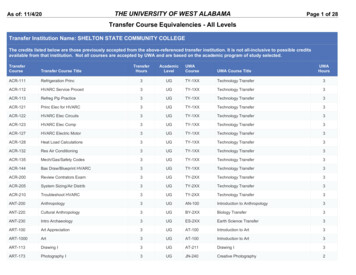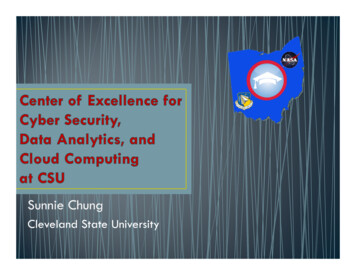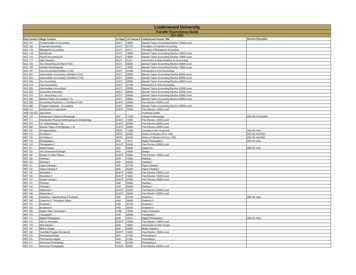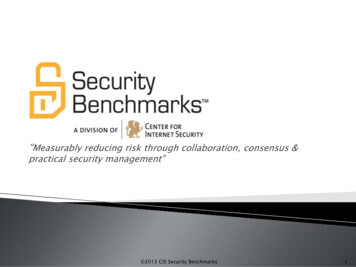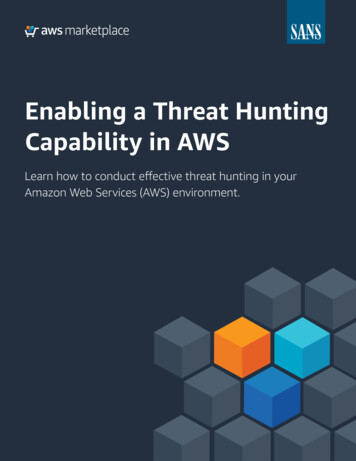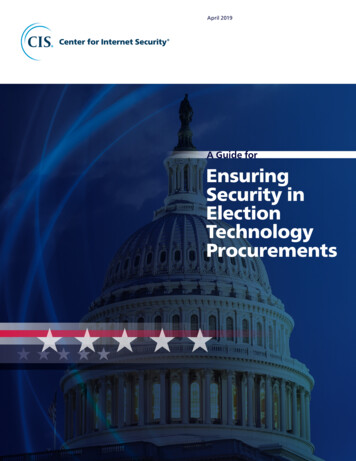
Transcription
April 2019A Guide forEnsuringSecurity inElectionTechnologyProcurements
About CISCIS is a forward-thinking, non-profit entity that harnesses the power of a globalIT community to safeguard private and public organizations against cyber threats.Our CIS Controls and CIS Benchmarks are the global standard and recognizedbest practices for securing IT systems and data against the most pervasive attacks.These proven guidelines are continuously refined and verified by a volunteer,global community of experienced IT professionals. CIS is home to the Multi-StateInformation Sharing and Analysis Center (MS-ISAC ), the go-to resource for cyberthreat prevention, protection, response, and recovery for U.S. State, Local, Tribal,and Territorial government entities, and the Elections Infrastructure InformationSharing and Analysis Center (EI-ISAC ), which supports the cybersecurity needsof U.S. State, Local and Territorial elections offices.Except as otherwise specified herein, the content of thispublication is licensed under Creative CommonsAttribution-NonCommercial-ShareAlike 4.0 mons.org/licenses/by-nc-sa/4.0/31 Tech Valley DriveEast Greenbush, New York 12061T: 518.266.3460F: 518.266.2085www.cisecurity.orgFollow us on Twitter @CISecurity
April 2019A Guide forEnsuringSecurity inElectionTechnologyProcurementsPart I:IntroductionPart II:Security Risk in Election TechnologyProcurementPart III:The Procurement ProcessPart IV:IT Product and Services LifecyclePart V:Cybersecurity Beyond Procurement Part VI:Best Practices for Cybersecurityin IT ProcurementAppendix A:Resources for Procurementand Related InformationAppendix B:Primer on the IT Procurement ces/
A Guide forEnsuring Security in Election Technology ProcurementsAcknowledgmentsCIS would like to recognize the following individuals andorganizations for their support in creating this guide.Their time and expertise were invaluable in completingthis important work.CIS authorsMike GarciaJohn GilliganAaron WilsonCommunity Contributions to and Review of the GuideLawrence Norden and Christopher DeluzioBrennan Center for JusticeDavid ForsceyNational Governors AssociationRahul K PatelCook County, IllinoisChris Wlaschin and Bryan FinneySector Coordinating Council, Election Infrastructure SubsectorMike GoetzElection Systems & SoftwareTrevor TimmonsState of ColoradoDavid StaffordEscambia County, FloridaRobert Giles and Kevin KearnsState of New JerseyJohn OdumMontpelier, VermontGeoff HaleU.S. Department of Homeland SecurityLeslie Reynolds, Maria Benson, Lindsey ForsonNational Association of Secretaries of StateRyan MaciasU.S. Election Assistance CommissionAmy CohenNational Association of State Election DirectorsRicky HatchWeber County, UtahDylan Lynch and Wendy UnderhillNational Conference of State LegislatorsThis report was made possible through support from the Democracy Fund.The content of this paper is the sole responsibility of CIS and may not reflectthe views of its funders.
A Guide forEnsuring Security in Election Technology ProcurementsPart 1: Introduction5Part I:Introduction
A Guide forEnsuring Security in Election Technology ProcurementsPart I: Introduction2Computer hardware, software, and services are essential for election operations. In nearly all election jurisdictions,many of the hardware, software, and services that underpin our elections—from voter registration and electionmanagement systems to pollbooks and vote capture devices—are procured from private vendors. Even simple publicfacing websites may be procured and their security—or lack thereof—may have consequences on elections. The industrypartners from which information technology (IT) is procured play a critical role in managing the security risksinherent in elections. Understanding and properly managing security expectations in the procurement process canhave a substantial impact on the success of the election process.About This GuideElection officials have limited resources, and procurements often have long lead times. Election officials are typicallyleft with tight windows between elections that move forward regardless of procurement and implementationschedules. Therefore, improving outcomes in the procurement process can have outsized impacts on the security ofadministering elections.The Center for Internet Security (CIS ) developed this guide benefiting from input and feedback from state and localgovernment, federal government, academic, and commercial stakeholders. It provides model procurement languagethat election officials can use to communicate their security priorities, better understand vendor security procedures,and facilitate a more precise cybersecurity dialogue with the private sector. The goal is to impact and improve thesecurity of election infrastructure by providing a set of specific security best practices for IT procurements in electionsthat complement the CIS publication, A Handbook for Elections Infrastructure Security, and other CIS best practices work.AudienceThis guide is intended for a nontechnical audience, including election officials, their staffs, and procurement officials,but may also be instructive for technical members of election teams. Vendors may find this information useful to helpunderstand how state and local election organizations will construct and evaluate their procurements.StructureThis guide is divided into these six main sections and two appendices, along with two online tools that will accompanythe traditional document: The Introduction includes “About This Guide” and “Audience”, and provides an overview of the motivationfor the guide and how to use it. Security Risk in Election Technology Procurement briefly describes assessing and managing security riskin election systems. The Procurement Process broadly describes the relationships between an election office, a procurementoffice, and state and local IT departments. This section provides some suggestions regarding governance thatcould help improve procurement outcomes. IT Product and Services Lifecycle describes product purchase and support, system development andmaintenance (including updates and patching), as well as services effort lifecycles showing that the work ofsecuring a procurement neither starts nor ends with the procurement itself. Cybersecurity Beyond Procurement describes the relationship between best practices in procurement andother practices and processes that should exist to provide assurance in the election security lifecycle. Best Practices for Cybersecurity in IT Procurement is a set of best practices that election officials can putinto requests for proposals and other procurement documents.
A Guide forEnsuring Security in Election Technology Procurements3Part 1: Introduction Appendices Appendix A—Resources for Procurement and Related Information: Links to procurement opportunities,training, and other useful information related to election procurement. Appendix B—Primer on the IT Procurement Process: Description of the typical IT procurement processapplicable across a range of organizations. Online Tools Elections Infrastructure Procurement Best Practice Tool: A web tool that allows filtering and exporting ofthe best practices in this document so that election officials can tailor the list to any given procurement. State IT buying guides and related information (coming soon): A set of links to individual state procurementand IT buying resources. They may be binding in your state or locality or may just be informational.UseThis guide includes best practices that election offices can use for planning, developing, and executing procurements.Each best practice has language that can be copied and pasted directly into requests for proposals (RFPs), requestsfor information (RFIs), and the like. The best practices also include descriptions of good and bad responses, tips, andhelpful references and links.In addition to the best practices, the earlier sections of this guide (on the procurement process, the IT procurementlifecycle, and cybersecurity beyond procurement) contain valuable information to improve your general knowledgeand to be used as a reference.While many of the best practices are derived from real-world procurements, those interested in reviewing languagefrom procurement materials should consult the U.S. Election Assistance Commission (EAC) Voting TechnologyProcurement clearinghouse.11 See Appendix A, Resources for Procurement and Related Information, for links to this and other useful resources.
Part II:Security Risk in ElectionTechnology Procurement
A Guide forEnsuring Security in Election Technology Procurements5Part II: Security Risk in Election Technology ProcurementAssessing RiskAll IT has risks. Efforts to mitigate some risks inevitably leave other risks unaddressed. Leaders must determine whichrisks are acceptable in the face of limited resources. To understand and prioritize their risks, all organizations shouldconduct regular risk assessments. Risk assessments can be sorted into two categories:1. Self-assessments: In-house risk assessments are generally faster and less expensive while still providing usefulinsight into your cybersecurity posture.2. Independent assessments: Because they are conducted by outside assessment specialists, independentassessments usually cost more and take longer, but they are more objective and thorough. Where time andresources permit, they are preferable even when an organization has deep cybersecurity experience.CIS offers a free assessment tool based on the best practices in A Handbook for Elections Infrastructure Security. This tool canbe used as a self-assessment tool or used by an independent assessment specialist, and provides a consistent approachfor election organizations to assess their own practices as well as track progress over time. For more information, s/.Figure 1:Risk AssessmentsA Handbook for Election Infrastructure SecurityBest practices for election securitySelf-assessmentsIndependent assessments In-house expertise Quicker and cheaper Useful, but less objective Outside assessment specialist Longer and more expensive More objective and more thoroughElection Infrastructure Assessment ToolConduct assessments and track progressOrganizational RiskIn a baseline risk assessment of election infrastructure described in A Handbook for Elections Infrastructure Security, CISidentified that the highest level of risk stems from those systems that are network-connected—connected to any network(not just the internet) at any time. This category includes most voter registration and election night reporting systems,and may also include some election management systems, e-pollbooks, and, in some cases, tabulation systems. Officialsmust make assessments of individual systems used by their organizations. Election officials should confirm that votingmachines are not network-connected, but these machines may still have substantial risks that require prioritization.Systems not connected to a network still require careful assessment and prioritized mitigation of risks. These indirectlyconnected systems are never connected to a network. The exchange of data between them, and with other systems,occurs indirectly through removable media such as USB drives.Beyond network-connected and indirectly connected systems and devices, an additional area of risk involvesthe transmission of data between systems. For example, ballot definitions and PDFs may be well-protected in thejurisdiction’s systems but have risk introduced when they are emailed to a third-party ballot printer.
A Guide forEnsuring Security in Election Technology ProcurementsPart II: Security Risk in Election Technology Procurement6These risks can and should be managed, and part of that process is understanding and managing cybersecurity risk inIT procurement.Figure 2:Categorizing Systems Based on Connections to Other Systems and DevicesNetwork ConnectedIndirectly ConnectedConnected to any network at any timeExchange data through removable mediaTransmission RisksExchange of data between systems through communication protocols(e.g., HTTPS, email, VPN)Individual System RiskOnce you understand the overall risk to your organization, you can prioritize actions and resources to reduce risks inindividual systems. For procured IT, this means ensuring that your requests for proposals and your contracts includerequirements for desirable system properties and mitigations. Crafting those requirements demands a cost-benefitanalysis, as most security controls impose a cost of some kind. Mandating that a vendor implement all possible securitycontrols might be impractical or undermine business objectives.We don’t recommend applying all of the best practices in this document to every system. Rather, some best practicesshould be implemented on all systems, others only on operational systems, and some only on critical systems. Forinstance, some basic website security measures should be applied to any system (so long as it has a website), whilethere are some advanced malware detection approaches that are expensive and difficult to implement and thus werecommend them for only critical systems.In the best practices section of this guide, we recommend one of these three classifications for systems applicability foreach best practice:1. All systems: The best practice is a reasonable investment to expect for any type of election system. It is vitalto ensure mitigation of the most common threats.2. Operational systems: The best practice is a reasonable investment for systems that are important tosuccessful election operations and thus carry greater risk. Systems with other security mitigations, backups,etc., may not need this best practice. Procurements of all critical systems and those with relatively high risksshould implement the best practice.3. Critical systems: The best practice is necessary only for critical systems, which is those with the highestconsequence of a successful attack. These are typically the most expensive and difficult to implementbest practices; requiring them will likely have an appreciable impact on the cost of your procurement but arelikely necessary to reduce risk to an acceptable level.These classifications serve as a starting point for differentiating between different types of systems in the electionstechnology procurement.
A Guide forEnsuring Security in Election Technology Procurements7Part II: Security Risk in Election Technology ProcurementFigure 3:Applicability of Best Practices Based on RiskAll:Best practice should be implementedon all systemsLow toModerateRiskIT SystemLow toModerateRiskIT ServiceOperational:Best practice should be implementedon systems required for electionoperations and with heightened riskModerateto HighRiskIT Systemor ServiceCritical:Best practice should be implementedon the most critical systems withthe highest consequence of asuccessful attackHighRiskIT Systemor Service
A Guide forEnsuring Security in Election Technology ProcurementsPart 1: Introduction12Part III:The Procurement Process
A Guide forEnsuring Security in Election Technology Procurements9Part III: The Procurement ProcessFor the purposes of successfully executing procurements, there are several aspects of governance worthy of attention.Protecting Confidential Security InformationCybersecurity often implicates a tradeoff between confidentiality in security techniques and maximizingtransparency of government activities. Many vendors are hesitant to share security information that, if disclosed, couldbenefit attackers or industry competitors. Yet government offices have a fundamental obligation to share informationwith the public. Election offices should consult with their legal and procurement teams to better understand whatinformation can be held closely, and what must be released. During procurements, this determination should be madeclear to potential proposers as well as how to mark information as proprietary and confidential. If you are unable toprotect vendor proprietary and confidential information from disclosure, you should expect to receive less detailedinformation from proposers.The PlayersTypically, election officials and their teams, procurement teams, and IT teams all have a role to play in electionprocurements. In many jurisdictions, poll workers and the public are also involved, and elected officials often have acritical role in setting priorities and budgets. To the extent possible, this is good for transparency and may also provideopportunities to educate about your approach to security.Election officials are the customer, and procurement and IT teams are there to help the election officials achieve theirgoals. While these different entities may be in the same organization, they may not always see the problem the sameway. Together, by focusing on their respective roles, these teams can complete efficient and effective procurements.
A Guide forEnsuring Security in Election Technology Procurements10Part III: The Procurement ProcessUnderstanding Common Procurement TypesThere are many ways to execute a procurement. Different procurement types are appropriate for differentcircumstances. This section will address three common approaches:1. Pre-negotiated contract: This is an agreement established by a government buyer with a schedulecontractor to fill repetitive needs for supplies or services.2 Pre-negotiated contracts include blanketpurchase agreements (BPAs), indefinite quantity indefinite delivery (IDIQ ) contracts, and schedule contracts(e.g., contracts awarded by the General Services Administration and available for use by state and localgovernment organizations).2. Lowest price technically acceptable: The award is made for a specific organizational requirement on thebasis of the lowest evaluated price of proposals meeting or exceeding the acceptability standards for non-costfactors. 33. Best value: These refer to tradeoffs between cost factors and non-cost factors, and allow the government toaward a contract for a specific organizational requirement other than the lowest priced. The perceivedbenefits of the higher priced proposal have to merit the additional cost, and the rationale should be welldocumented. 4Figure 4:Types of Procurements Best for simple and commodity purchases Usually fastest and cheapest Limited flexibilityPre-negotiatedContractsLowest Price Best when requirements are well-definedand readily achievable Work well when there is little differentiationbetween proposersBest Value Best for complex systems and thosewith interdependencies Require justification Will usually be best for specializedelection systems2 ase-agreements3 4 rocess#
A Guide forEnsuring Security in Election Technology ProcurementsPart III: The Procurement Process11Pre-negotiated contracts are typically the fastest way to make procurements, as terms and prices are alreadynegotiated. State and local governments can usually buy off of their own state’s schedules or the federal government’sschedules, saving a great deal of time and effort. Because these agreements are typically negotiated for large quantities,prices are usually favorable. Pre-negotiated contracts can be great if they meet exactly what you need (and for thisreason, Appendix A, Resources for Procurement and Related Information, lists a federal resource for pre-negotiatedcontracts and a similar option provided by CIS). But, historically, these contracts have not always been sufficienton their own for achieving appropriate levels of security. It’s important to look at them but be sure to vet them forappropriateness—and ask an IT security expert if you need help. Note also that in some states, there are existing prenegotiated contracts that may either drive toward a particular solution or in some cases require it. Most procurementsof commodity IT, such as basic computer and server purchases, should be under a pre-negotiated contract.When no item on a schedule meets the needs of the procurement, you need to conduct an independent procurement.There are two main types: lowest price and best value. When you can clearly describe all of the requirements for aprocurement, and multiple sellers can meet those requirements in similar and easily demonstrable ways, lowest-priceprocurements make the most sense.For specialized procurements, best-value procurements are usually best. This will typically include hardware,software, or services that are specialized for elections. Similarly, risk mitigation in cybersecurity can be difficult toassess and describe before seeing a solution, so best-value procurements often lead to better security outcomes. Mostprocurements of election-specific IT should be conducted as best-value procurements.Procurement offices sometime shy away from best-value procurements because of the difficulty many IT experts havein assessing the value of different solution features in financial terms. This can open the door for unfair decisions—whether actual or perceived—so procurement officers often require additional justification before allowing aprocurement to go forward as best value. These justifications give confidence that the best-value determinations aremade on an objective basis.In making a justification for a best-value procurement, consider how you can describe incremental value associatedwith reaping additional benefits or eliminating risks. For instance: Is there other hardware or software that you’ll no longer need to purchase because the more expensive optionhas a particular additional feature? Will the solution result in reduced operating costs due to fewer errors, provide for increased capabilitiesresulting in a greater portion of the job being done in an automated fashion, or result in the likely eliminationof the need for other systems or staffing? Can you reduce risk (and consequently avoid cost overruns) because of the more expensive approach? If so,what is reducing this risk worth? What types of non-monetary value can you consider? Does a better security approach reduce reputationalrisk? Political risk? Can you estimate a range of financial value for reducing that risk?The good and bad response descriptions in the best practices found in this guide can help with some of thosejustifications.Understanding these differing approaches to procurements—and being prepared to defend your rationale—can makeor break a procurement. Above all, be prepared to be your own advocate for your needs.
A Guide forEnsuring Security in Election Technology ProcurementsPart 1: Introduction16Part IV:IT Product andServices Lifecycle
A Guide forEnsuring Security in Election Technology ProcurementsPart IV: IT Product and Services Lifecycle13Poor IT procurement can undermine other positive efforts to manage cybersecurity risk. Cybersecurity outcomes aredriven by the details of IT systems and their implementation at each stage of the IT product’s or service’s life.The normal lifecycle for IT products involves hardware and software development, integration, patching, service andmaintenance, and end-of-life transition. Security vulnerabilities can emerge at any point in the IT lifecycle and maybe difficult to detect and eliminate later. When planning a procurement, you must think about this full lifecycle thatbegins before the procurement and ends well after it.Each of these items has implications for the IT procurement process. Only through quality hardware, software, andservices procurements can you expect to have success managing cybersecurity risk throughout the election process.Any deficiencies in design, implementation, integration, or configuration can lead to vulnerabilities that can beidentified and exploited by malicious actors.Appendix B, Primer on the IT Procurement Process, contains more general information on the IT lifecycle and how toexecute a procurement.Figure 5:The IT LifecycleDevelopmentand IntegrationEnd-of-contractand End-of-lifeTransitionPatching andMaintenance
A Guide forEnsuring Security in Election Technology ProcurementsPart 1: Introduction18Part V:Cybersecurity BeyondProcurement
A Guide forEnsuring Security in Election Technology ProcurementsPart V: Cybersecurity Beyond Procurement15Most election officials aren’t experts in cybersecurity. Fortunately, most states have developed approaches to assistelection officials that are not as proficient in securing election technology and infrastructure. 5 Additionally,organizations like CIS, Harvard’s Belfer Center, and the Department of Homeland Security’s Election InfrastructureSubsector Government Coordinating Council (EIS-GCC) produce resources that can help with these cybersecuritydecisions.Following the recommendations in this guide will improve security outcomes in your procurements. Still, you mustalso have processes in place that will maintain the assurance you gained in the procurement process. Here’s a simpleexample: you need USB sticks to program your voting machines. You follow all the appropriate recommendations formaking such a hardware procurement, and from that perspective you’ve done everything right. But how you managethose USB sticks from the time you sign off on the package until you’ve put them in your election management systemand subsequently into each voting machine will impact your outcomes as much as the initial purchase.For this reason, your overall IT security approach must combine quality procurement practices with operationalsecurity, such as by coupling this guide with the CIS resource, A Handbook for Elections Infrastructure Security.5 CIS will be highlighting these state-by-state resources in a website currently under development.When available, you’ll be able to access them at https://www.cisecurity.org/elections-resources/.
A Guide forEnsuring Security in Election Technology ProcurementsPart 1: Introduction20Part VI:Best Practices for Cybersecurityin IT Procurement
A Guide forEnsuring Security in Election Technology ProcurementsPart VI: Best Practices for Cybersecurity in IT Procurement17This guide contains a set of best practices that election officials can use in their procurements to improve securityoutcomes. The best practices are intended to generate responses from potential vendors that can help election officialsmake informed decisions.For each of the best practices, we provide a few classifications to help understand and prioritize their use. Each bestpractice can fall under multiple items within each category. For instance, a best practice may address hardware,software, services, or cloud-based IT, or it may apply to some combination of those. While we also provide descriptionsof good and not-so-good responses, for all of this guidance, it’s up to the officials to know if a proposer’s response meetstheir needs. The online tool has more filtering options that we couldn’t neatly fit into the tables.The following table provides the format of each best practice and includes: A description of the best practice, numbered sequentially beginning with #1 A classification for system applicability as described above The type of IT to which the recommendation applies Suggested language you can put in your procurement documents A description of a good response or activity A description of a bad response or activity Some additional tips, if any Helpful references and links, if anyPractice: #System applicability:IT type:DescriptionThe type of systems to whichthe recommendation applies: All Operational CriticalThe type of IT to which therecommendation applies: Hardware Software Services CloudSuggested language:This is recommended language you can include in your procurement documents. It will most often be in the form ofa question for an RFI or RFP but could also list what to look for in other aspects of procurement or what to include in acontract.Good:A description of a good response to the recommendation or language to include in a procurement document.Bad:A description of a poor response to the recommendation or language to include in a procurement document.Tips:Additional details that might make for a more successful procurement.References and links:Resources or websites that may be helpful.
A Guide forEnsuring Security in Election Technology ProcurementsPart VI: Best Practices for Cybersecurity in IT Procurement18Successful organizations are often analyzed along their approach to people, process, and technology. We organize ourrecommendations for procurement best practices along these three facets of a potential contractor’s work, thoughnone is more important than another: People: Ensuring that the people have the right expertise and experience in cybersecurity. Process: Ensuring the proposer has the correct approaches to achieve the outcomes it claims. Technology: Ensuring the proposer can deliver IT solutions that meet the security needs of your organization.Best Practices—PeoplePractice: #1Qualifications and experience of individualsproposed for work.System applicability: AllIT type: Hardware Software ServicesSuggested language:Provide qualifications and experience of all proposed personnel, including subcontractors. In addition to basicqualifications (e.g., certifications obtained), include descriptions of experience in the area of elections or cybersecurity,or both. Where applicable, provide any specific knowledge and experience with state and local policies, architecture,and related aspects of the proposed work.Good:While combined experience of a team is valuable, it’s not always sufficient. T
Beyond network-connected and indirectly connected systems and devices, an additional area of risk involves . jurisdiction's systems but have risk introduced when they are emailed to a third-party ballot printer. A Handbook for Election Infrastructure Security Best practices for election security
